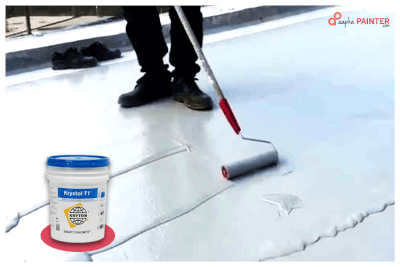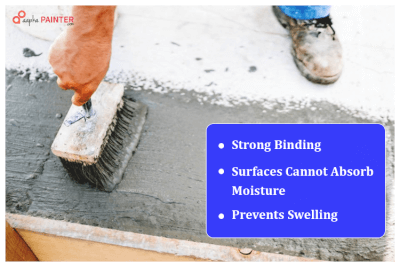Table of Contents
The Difference between Cementitious and Crystalline Coating
Although concrete is supposedly one of the strongest construction materials, we cannot deny that it suffers from erosion, corrosion, and oxidative damage when exposed to external components. For example, when you leave concrete under the sun for a long time, you can see cracks forming along the edges.
Similarly, concrete can lose its surface when exposed to extremely high traffic movement, like roads and commercial driveways. This is why most concrete surfaces are coated with special materials to reduce the rate of wear and tear and prolong the lifetime of the concrete structures.

There are two such coating types usually implemented in the construction industry. These are cementitious and crystalline coatings. Each has different characteristics, advantages, and disadvantages. In this article, we are going to study everything about these coating types along with a parallel study to understand the differences.
What is the cementitious coating?
Concrete is not waterproof. Therefore, a special coating is applied on the surfaces to make them resistant to water and prevent any damage due to water ingress, moisture absorption, and so on. This coating is made from cement and other aggregates to increase the binding power and prevent the water for the longest possible time.
It is applied on walls, floors, and even ceilings. Plus, it is compatible both indoors and outdoors. Portland cement is one of the major constituents of cementitious coating, and another additive is used that acts as the binding agent. This binding agent increases the adhesion force of the coating, keeping it in place and helping it protect the concrete surface from damage.
What is the crystalline coating?

The crystalline coating is one of the best ways to prevent concrete surfaces from damage due to external agents. It forms an impenetrable barrier over the porous concrete, preventing water from seeping. The barrier is so strong that concrete structures cannot absorb moisture, no matter how high the humidity is. As a result, the sealing capability of the crystalline coating is much better. It helps the concrete to self-seal and prevents the water from seeping further and damaging the structures within.
Advantages and disadvantages of cementitious coating
Advantages of cementitious coating
- One of the major benefits of cementitious coating is its strong binding force with the concrete surface. As a result, it is difficult to strip off the coating and expose the concrete surface to erosive and abrasive components.
- The coating is waterproof. Therefore, the concrete surfaces cannot absorb moisture. This prevents swelling from the inside and moldy growth.
- There is no doubt that cementitious coating extends the lifetime of concrete structures, especially the ones present in high-humidity areas.
- Another significant benefit of applying the cementitious coating is its ability to resist damage to the concrete surface due to high temperature, a chemical reaction (oxidation), and mechanical abrasions.
- The coating can endure different pressure movements, both low and high, which is why it can be applied on multiple surfaces easily.
Disadvantages of cementitious coating
- One of the major disadvantages of cementitious coating is its ability to respond to ambient temperature and contract or expand based on the water content.
- Another drawback of the coating is its inability to protect the joints from cracks and holes. You won’t be able to use it as the grout material for fixing these problems.
Advantages and disadvantages of crystalline coating
Advantages of crystalline coating
- One of the major benefits of the crystalline coating is that it is impervious and does not allow a single drop of water to seep through. Therefore, the concrete structures will remain protected for the longest possible time.
- Since the water ratio in the crystalline coating is less, the layer is not subjected to expansion and contraction due to temperature and humidity. Although the aggregates used in the coating tend to shrink or contract, the chosen materials usually have lower values for the coefficient of thermal expansion.
- Another significant benefit of the crystalline coating is that it is less fragile and therefore won’t form cracks too soon. Therefore, you won’t have to worry about applying the same repeatedly.
- Due to the inclusion of different crystals, the coating adds more value to the overall aesthetics of the concrete structure. It is often used indoors, like the lobbies, walls, etc.
- It does not just stick to the concrete surface. Instead, it transforms the concrete into an impenetrable material, creating a strong and unbreakable bond. It is due to this reason the coating can perform so well.
Disadvantages of crystalline coating
- Since the coating is hard, it cannot withstand too much pressure. Therefore, its application on surfaces with high traffic movement is not feasible.
- Application of crystalline coating is a costly process and hence is not used much, especially for larger surfaces.
Conclusion
In this article, you have understood the advantages and disadvantages of the cementitious and crystalline coatings applied to strengthen the concrete further and waterproof the surface. They also ensure the concrete structure is not damaged due to temperature, humidity, and cracks. However, deciding which coating to apply to the concrete is important.
FAQs
Q. Which is better for residential concrete flooring- cementitious or crystalline coating?
A. Cementitious coating is much better for residential flooring because it is cheaper, and the concrete floors are not usually exposed to high humidity or extreme temperatures. Also, you won’t have to worry much about damage from mechanical abrasions.
Q. Which coating is costlier- cementitious or crystalline?
A. The crystalline waterproofing coating is much costlier than the cementitious one. This is because, in the crystalline coating, several aggregates are mixed along with resin instead of water. Therefore, the cost is higher than a cementitious coating, where cement, water, and a binding agent are only used.
Q. Does cementitious coating last longer or crystalline coating?
A. The longevity of the crystalline and cementitious coatings depends on several factors. For example, if we consider humidity and high-temperature exposure, the crystalline coating will last longer than the cementitious coating. But if we consider the movement of high-pressure traffic. Then go for the cementitious coating.
